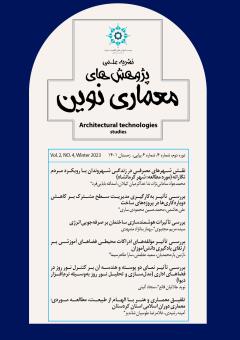بررسی تاثیر مولفههای ادراکات محیطی فضاهای آموزشی بر ارتقای یادگیری دانشآموزان
محورهای موضوعی :
نازنین یارمحمدیان
1
,
سعید عظمتی
2
![]() ,
سارا طاهرسیما
3
,
سارا طاهرسیما
3
1 - دانشجوي كارشناسي ارشد، گروه معماري، دانشكده هنر معماري، واحد تهران شرق، دانشگاه آزاد اسلامي، تهران، ايران.
2 - استادیار گروه معماری، دانشکده هنر و معماری، واحد تهران شرق، دانشگاه آزاد اسلامی، تهران، ایران.
3 - استادیار گروه معماری، واحد تهران شرق، دانشگاه آزاد اسلامی، تهران، ایران.
کلید واژه: ادراکات محیطی , فضاهای آموزشی , ارتقای یادگیری, دانشآموزان,
چکیده مقاله :
هر کودک در مدرسه بخش مهمی از عمر خود را میگذراند که هدف از این حضور در مدارس آموختن و پرورش توانایی و مهارت کودک و رفتارهای فردی و اجتماعی است. طراحی نامناسب محیط مدرسه سبب نارضایتی ، خستگی و کاهش یادگیری آنها میشود. اهمیت به ويژگي هاي روحي دانشآموزان و الگوهاي رفتاری آنها در طراحي محيط هاي آموزشي و مدارس ، ميتواند به يادگيري آنان و شكوفايي استعدادهای آنها كمك كند. درنتیجه، طراحي مدرسه و فضای آموزشی با توجه به نيازهاي ويژه كودكان، از اهميتي ويژه برخوردار است. آنچه كه اين مقاله به آن پرداخته جنبه هاي متفاوت تاثير فضاي آموزشي و مولفههای ادراکات محیطی اين فضاها بر يادگيري كودكان با رويكرد ارتقای یادگیری دانشآموزان میباشد. پژوهش حاضر، به لحاظ هدف، کاربردی و به لحاظ روش انجام تحقیق، تحقیق پیمایشی- تحلیلی میباشد. پژوهشگر به منظور سنجش ديدگاه دانشآموزان ، با مطالعه و دستهبندی پژوهش های پیشین به تدوين جدول هدف- محتوا پرداخته است و با توجه به اين جدول پرسشنامهای طراحي کرده است، و همچنین از روش نمونهگیری تصادفی ساده استفاده شده است.برای بررسی روایی سازه 40 پرسشنامه بین متخصصان توزیع گردید و از تحلیل عاملی تأییدی و نرمافزار SPSS بهمنظور بررسی روایی سازه استفاده شده است. نتيجه حاصل از این پژوهش بيان ميكند كه مولفههایی برگرفته از ادراک محیطی، نظیر: تنوع چیدمان مبلمان و مبلمان انعطافپذیر و متحرک، فضاهایی با امکان تعاملات مشارکتی، ترکیب متناسب رنگ در فضا، ورودی و مسیرهای خوانا و دعوت کننده، زمین شنبازی، حضور آب، تراس هایی در امتداد کلاسها در طبقات، پارک مشارکتی، گودال باغچه، پنجره های قدی و نورگیر و... در ارتقای یادگیری دانشآموزان موثر عمل می نمایند.
Every child spends an important part of his life in school. The purpose of this presence in schools is to learn and develop the child's abilities and skills, as well as individual and social behaviors. Improper design of the school environment causes dissatisfaction, fatigue and decrease in their learning. Paying attention to the mental and physical characteristics of children and their behavioral patterns in the design of educational environments and the impact of environmental perceptions can help children's learning and the emergence of talents and ultimately their growth and prosperity. Hence, designing schools according to the needs It is especially important for children between 6-12 years old. What this article deals with is the different aspects of the effect of educational spaces and the components of environmental perceptions of these spaces on children's learning with the approach of improving students' learning. The current research is applied in terms of its purpose and survey-analytical in terms of the research method. The result shows that the factors that make up the educational environment are effective in facilitating children's learning and this effect is such that the sum of these factors together provide conditions so that students can focus more easily on the subject matter in order to improve Let them learn. And also this research states that components derived from environmental perception, such as: variety of furniture arrangement and flexible and movable furniture, spaces with the possibility of collaborative interactions, appropriate combination of colors in the space, readable and inviting entrances and paths, sand playground , the presence of water, terraces along the classes on the floors, participatory park, garden pit, tall and light windows, etc. are effective in improving students' learning.
